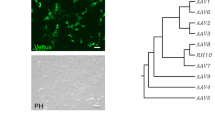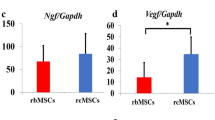Abstract
We evaluated the therapeutic effect of erythropoietin (EPO) delivered by direct injection of a nonreplicating herpes simplex virus (HSV)-based vector coding for EPO (vEPO) in a model of cervical hemicord contusion at C7. At 1 h after spinal cord injury (SCI), either vEPO or control vector carrying a reporter gene (vC) was injected into the cord above and below the lesion. Animals injected with vEPO showed a statistically significant improvement in the ipsilateral forelimb function, as measured by open-field evaluation of motor performance, forelimb reaching in the cylinder test and misplacement in grid walk. This correlated with preservation of gray matter in the area of the lesion. There was also mild but significant improvement of hindlimb motor function measured by Basso–Beattie–Bresnahan score and computerized gait analysis in vEPO compared with control vector-injected animals. Microtubule-associated protein tau, phosphorylated and nonphosphorylated neurofilament protein and the synaptic proteins synaptophysin and PSD-95 were all significantly increased in the spinal cord of vEPO-treated animals compared with control vector-injected animals. These data suggest that gene transfer of EPO after cervical SCI by minimizing the injury size and enhancing tissue sparing preserves large-caliber axons and promotes synaptogenesis.
This is a preview of subscription content, access via your institution
Access options
Subscribe to this journal
Receive 12 print issues and online access
$259.00 per year
only $21.58 per issue
Buy this article
- Purchase on Springer Link
- Instant access to full article PDF
Prices may be subject to local taxes which are calculated during checkout






Similar content being viewed by others
References
Jackson AB, Dijkers M, Devivo MJ, Poczatek RB . A demographic profile of new traumatic spinal cord injuries: change and stability over 30 years. Arch Phys Med Rehabil 2004; 85: 1740–1748.
Anderson KD . Targeting recovery: priorities of the spinal cord-injured population. J Neurotrauma 2004; 21: 1371–1383.
Grasso G . An overview of new pharmacological treatments for cerebrovascular dysfunction after experimental subarachnoid hemorrhage. Brain Res Brain Res Rev 2004; 44: 49–63.
Grasso G, Sfacteria A, Cerami A, Brines M . Erythropoietin as a tissue-protective cytokine in brain injury: what do we know and where do we go? Neuroscientist 2004; 10: 93–98.
Brines M, Grasso G, Fiordaliso F, Sfacteria A, Ghezzi P, Fratelli M et al. Erythropoietin mediates tissue protection through an erythropoietin and common beta-subunit heteroreceptor. Proc Natl Acad Sci USA 2004; 101: 14907–14912.
Puskovic V, Wechuck J, Krisky D, Collins J, Glorioso JC, Fink DJ et al. HSV-mediated delivery of erythropoietin restores dopaminergic function in MPTP-treated mice. Mol Ther 2006; 14: 710–715.
Chattopadhyay M, Walter C, Mata M, Fink DJ . Neuroprotective effect of herpes simplex virus-mediated gene transfer of erythropoietin in hyperglycemic dorsal root ganglion neurons. Brain 2009; 132: 879–888.
Zai LJ, Yoo S, Wrathall JR . Increased growth factor expression and cell proliferation after contusive spinal cord injury. Brain Res 2005; 1052: 147–155.
Kwon BK, Okon E, Hillyer J, Mann C, Baptiste D, Weaver LC et al. A systematic review of non-invasive pharmacologic neuroprotective treatments for acute spinal cord injury. J Neurotrauma 2011; 28: 1545–1588.
Lee MK, Cleveland DW . Neuronal intermediate filaments. Annu Rev Neurosci 1996; 19: 187–217.
Bernaudin M, Marti HH, Roussel S, Divoux D, Nouvelot A, MacKenzie ET et al. A potential role for erythropoietin in focal permanent cerebral ischemia in mice. J Cereb Blood Flow Metab 1999; 19: 643–651.
Celik M, Gokmen N, Erbayraktar S, Akhisaroglu M, Konakc S, Ulukus C et al. Erythropoietin prevents motor neuron apoptosis and neurologic disability in experimental spinal cord ischemic injury. Proc Natl Acad Sci USA 2002; 99: 2258–2263.
Brines M, Cerami A . Emerging biological roles for erythropoietin in the nervous system. Nat Rev Neurosci 2005; 6: 484–494.
Hoffman PN, Griffin JW, Price DL . Control of axonal caliber by neurofilament transport. J Cell Biol 1984; 99: 705–714.
Elder GA, Friedrich Jr VL, Kang C, Bosco P, Gourov A, Tu PH et al. Requirement of heavy neurofilament subunit in the development of axons with large calibers. J Cell Biol 1998; 143: 195–205.
Mata M, Kupina N, Fink DJ . Phosphorylation-dependent neurofilament epitopes are reduced at the node of Ranvier. J Neurocytol 1992; 21: 199–210.
Ransome MI, Turnley AM . Erythropoietin promotes axonal growth in a model of neuronal polarization. Mol Cell Neurosci 2008; 38: 537–547.
Kang CE, Poon PC, Tator CH, Shoichet MS . A new paradigm for local and sustained release of therapeutic molecules to the injured spinal cord for neuroprotection and tissue repair. Tissue Eng Part A 2009; 15: 595–604.
Siren AL, Fasshauer T, Bartels C, Ehrenreich H . Therapeutic potential of erythropoietin and its structural or functional variants in the nervous system. Neurotherapeutics 2009; 6: 108–127.
Ning B, Zhang A, Song H, Gong W, Ding Y, Guo S et al. Recombinant human erythropoietin prevents motor neuron apoptosis in a rat model of cervical sub-acute spinal cord compression. Neurosci Lett 2011; 490: 57–62.
Nagai A, Nakagawa E, Choi HB, Hatori K, Kobayashi S, Kim SU . Erythropoietin and erythropoietin receptors in human CNS neurons, astrocytes, microglia, and oligodendrocytes grown in culture. J Neuropathol Exp Neurol 2001; 60: 386–392.
Grasso G, Sfacteria A, Passalacqua M, Morabito A, Buemi M, Macri B et al. Erythropoietin and erythropoietin receptor expression after experimental spinal cord injury encourages therapy by exogenous erythropoietin. Neurosurgery 2005; 56: 821–827.
Wu Z, Mata M, Fink DJ . Prevention of diabetic neuropathy by regulatable expression of HSV-mediated erythropoietin. Mol Ther 2011; 19: 310–317.
Wolfe D, Mata M, Fink DJ . A human trial of HSV-mediated gene transfer for the treatment of chronic pain. Gene Therapy 2009; 16: 455–460.
Martinez M, Brezun JM, Bonnier L, Xerri C . A new rating scale for open-field evaluation of behavioral recovery after cervical spinal cord injury in rats. J Neurotrauma 2009; 26: 1043–1053.
Schallert T, Fleming SM, Leasure JL, Tillerson JL, Bland ST . CNS plasticity and assessment of forelimb sensorimotor outcome in unilateral rat models of stroke, cortical ablation, parkinsonism and spinal cord injury. Neuropharmacology 2000; 39: 777–787.
Bresnahan JC, Beattie MS, Todd III FD, Noyes DH . A behavioral and anatomical analysis of spinal cord injury produced by a feedback-controlled impaction device. Exp Neurol 1987; 95: 548–570.
Kunkel-Bagden E, Dai HN, Bregman BS . Recovery of function after spinal cord hemisection in newborn and adult rats: differential effects on reflex and locomotor function. Exp Neurol 1992; 116: 40–51.
Basso DM, Beattie MS, Bresnahan JC . A sensitive and reliable locomotor rating scale for open field testing in rats. J Neurotrauma 1995; 12: 1–21.
Acknowledgements
We acknowledge the assistance of Vikram Thakur in vector propagation.
Author information
Authors and Affiliations
Corresponding author
Ethics declarations
Competing interests
The authors declare no conflict of interest.
Rights and permissions
About this article
Cite this article
Wang, S., Wu, Z., Chiang, P. et al. Vector-mediated expression of erythropoietin improves functional outcome after cervical spinal cord contusion injury. Gene Ther 19, 907–914 (2012). https://doi.org/10.1038/gt.2011.166
Received:
Revised:
Accepted:
Published:
Issue Date:
DOI: https://doi.org/10.1038/gt.2011.166
Keywords
This article is cited by
-
Rodent Models of Spinal Cord Injury: From Pathology to Application
Neurochemical Research (2023)



